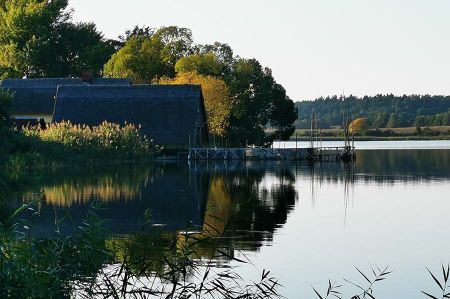Hike along the Lohmen Archaeological Trail
- Written by Portal Editor
In the mid-1990s, bulldozers were levelling the area for the construction of the Lohmen rehabilitation clinic when a Bronze Age settlement was discovered.
The Lohmen amateur painter Kurt Schwinkendorf has used reconstruction drawings of similar farms to depict what this settlement might have looked like. It was not the first find of this kind in the region: Stone Age tools were found in the cemetery and the remains of a pile-dwelling settlement are believed to be at Lohmer Lake.
5,000 years of settlement history in the Lohmen region
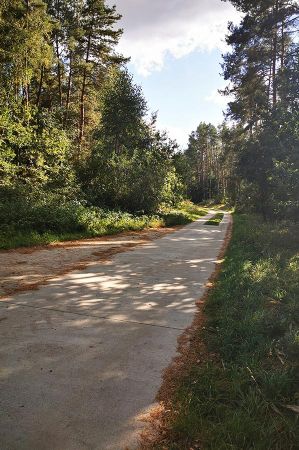 The territory of today's municipality, which includes the districts of Lohmen, Oldenstorf, Nienhagen, Garden, Altenhagen, Rothbeck, Gerdshagen and Lähnwitz (approx. 4160 ha), has been a human settlement area for at least 5000 years.
The territory of today's municipality, which includes the districts of Lohmen, Oldenstorf, Nienhagen, Garden, Altenhagen, Rothbeck, Gerdshagen and Lähnwitz (approx. 4160 ha), has been a human settlement area for at least 5000 years.
Some of the visible remains such as megalithic tombs, Bronze Age burial mounds and boundary stones have been documented since September 9, 2001 on the now almost 30 km long archaeological trail. The trail was created in cooperation between the communities of Lohmen and Klein Upahl.
With the Lenzener Steintanz, it also includes an archaeological monument from the neighbouring district. We want to walk at least part of it today, because our goal today is the Bronze Age burial mounds in the Lohmer Stüde.
Destination Lake Lohmer and burial mounds Lohmer Stüde
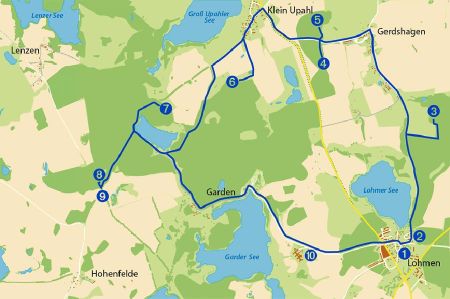 From the campsite, we first walk along the Garder See and the road to the Lohmer See, with the path leading past the rehabilitation clinic and then to the left into the forest.
From the campsite, we first walk along the Garder See and the road to the Lohmer See, with the path leading past the rehabilitation clinic and then to the left into the forest.
After crossing the quiet country road, we reach the Lohmer See and follow the forest path up to the Lohmer Stüde.
From Lake Lohmer it is about 4 kilometres to the signpost Lohmer Stüde, where you leave the concrete track and turn right into the forest. After about another kilometre you turn left into the forest and after another 500 meters you reach the first burial mound.
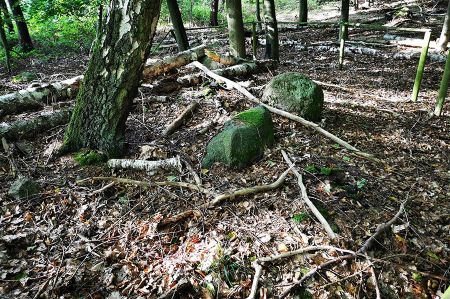 At the time of our visit, it was unfortunately quite unsightly, as birch wood and other branches that had been broken off by the storm were lying on the burial mound, making it difficult to recognize the actual grave.
At the time of our visit, it was unfortunately quite unsightly, as birch wood and other branches that had been broken off by the storm were lying on the burial mound, making it difficult to recognize the actual grave.
So, we were rather disappointed with the burial mound and its maintenance, but once again we were interested in the hike itself, which was a wonderful experience and was rewarded with great views of Lohmer See and Garder See.
On the way back to the granary and the parsonage barn
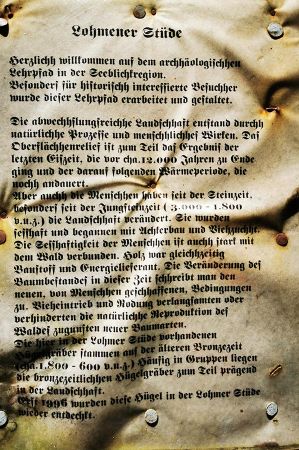 After the disappointing burial mound in the Lohmer Stüde, we wanted to visit the parsonage barn on the way back, which is also home to the tourist information office.
After the disappointing burial mound in the Lohmer Stüde, we wanted to visit the parsonage barn on the way back, which is also home to the tourist information office.
In the parsonage barn - open on weekdays from 8 a.m. to 4 p.m. - you can see impressive wooden beam architecture up to the thatched roof as well as older equipment for processing feed.
The other facilities in the village are made accessible as part of village tours, or a visit to them on the 30 km long archaeological trail is another recommended hiking destination, which also applies to the village church.
The Speicher Museum collects, preserves and presents historical monuments, material evidence and documents from the history of rural areas on just over 1,000 m² of floor space in its five buildings as well as on the trails and open spaces.
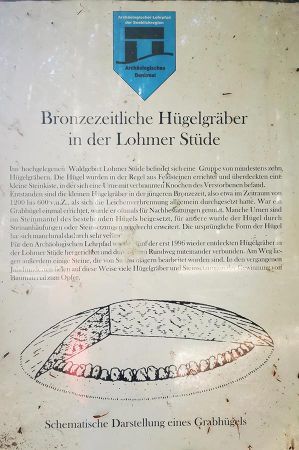 The collection focuses on local history, folklore, work, craft and everyday equipment, toys, teaching and learning materials, textiles, documents, written material, postcards and photos, especially from the 20th century.
The collection focuses on local history, folklore, work, craft and everyday equipment, toys, teaching and learning materials, textiles, documents, written material, postcards and photos, especially from the 20th century.
One of the special features is that the museum was created with the participation of many residents of the region, the municipality and the Güstrow Region Association.
Important projects were also supported by state and federal authorities.
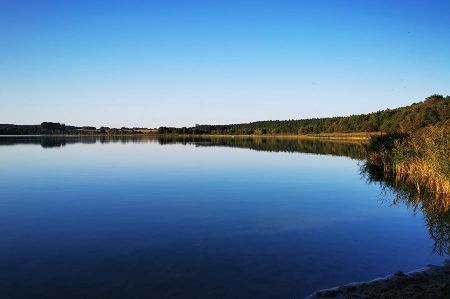 The granary on Chausseestrasse - built in 1910 as a barn on a hereditary farm - is open from May to October, Tues. - Sat. 3 p.m. - 5 p.m. Special and permanent exhibitions on various topics can be viewed here.
The granary on Chausseestrasse - built in 1910 as a barn on a hereditary farm - is open from May to October, Tues. - Sat. 3 p.m. - 5 p.m. Special and permanent exhibitions on various topics can be viewed here.
The residents of the region and their guests have collected everyday objects and tools from everyday life, farming and gardening and crafts that reflect the development of rural life and work over the course of the 20th century since the end of the 19th century.
Admission to the granary is free, but any donation is welcome.
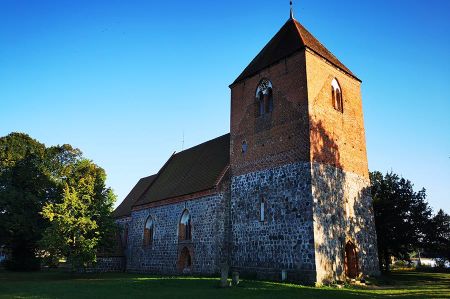 The settlements of Lohmen, Garden and Lähnwitz already existed before German colonization due to the presumed Slavic origin of their names. The villages of Oldewinesthorp, Gerardershagen, Woluerameshagen and Nienhagen were - as the names show - founded during the German colonization and Christianization around the years 1200 to 1227.
The settlements of Lohmen, Garden and Lähnwitz already existed before German colonization due to the presumed Slavic origin of their names. The villages of Oldewinesthorp, Gerardershagen, Woluerameshagen and Nienhagen were - as the names show - founded during the German colonization and Christianization around the years 1200 to 1227.
Please read as well:
Lake Garder - A paradise for nature lovers and adventurers
From the Rijksmuseum Amsterdam to the flower market
-
 Hiking along archeological path Lohmen
Hiking along archeological path Lohmen
Hiking along archeological path Lohmen
Hiking along archeological path Lohmen
-
 Hiking along archeological path Lohmen
Hiking along archeological path Lohmen
Hiking along archeological path Lohmen
Hiking along archeological path Lohmen
-
 Hiking along archeological path Lohmen
Hiking along archeological path Lohmen
Hiking along archeological path Lohmen
Hiking along archeological path Lohmen
-
 Hiking along archeological path Lohmen
Hiking along archeological path Lohmen
Hiking along archeological path Lohmen
Hiking along archeological path Lohmen
-
 Hiking along archeological path Lohmen
Hiking along archeological path Lohmen
Hiking along archeological path Lohmen
Hiking along archeological path Lohmen
-
 Hiking along archeological path Lohmen
Hiking along archeological path Lohmen
Hiking along archeological path Lohmen
Hiking along archeological path Lohmen
https://www.alaturka.info/en/hiking-tours/6756-hike-along-the-lohmen-archaeological-trail#sigProId8f29371743
